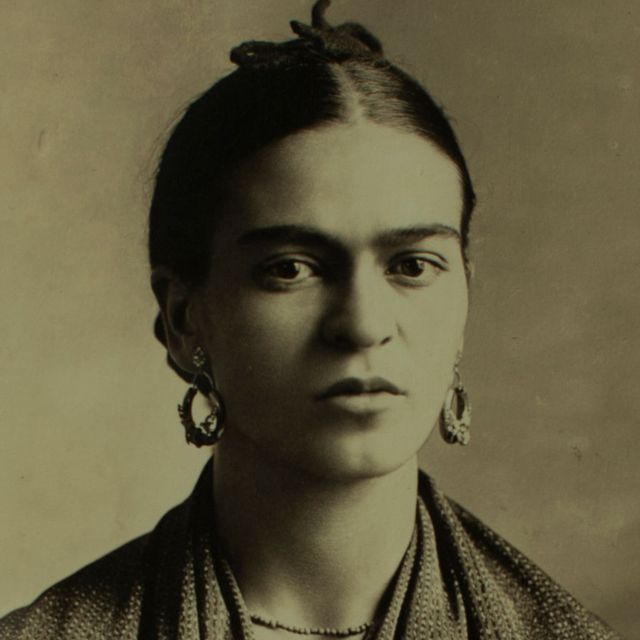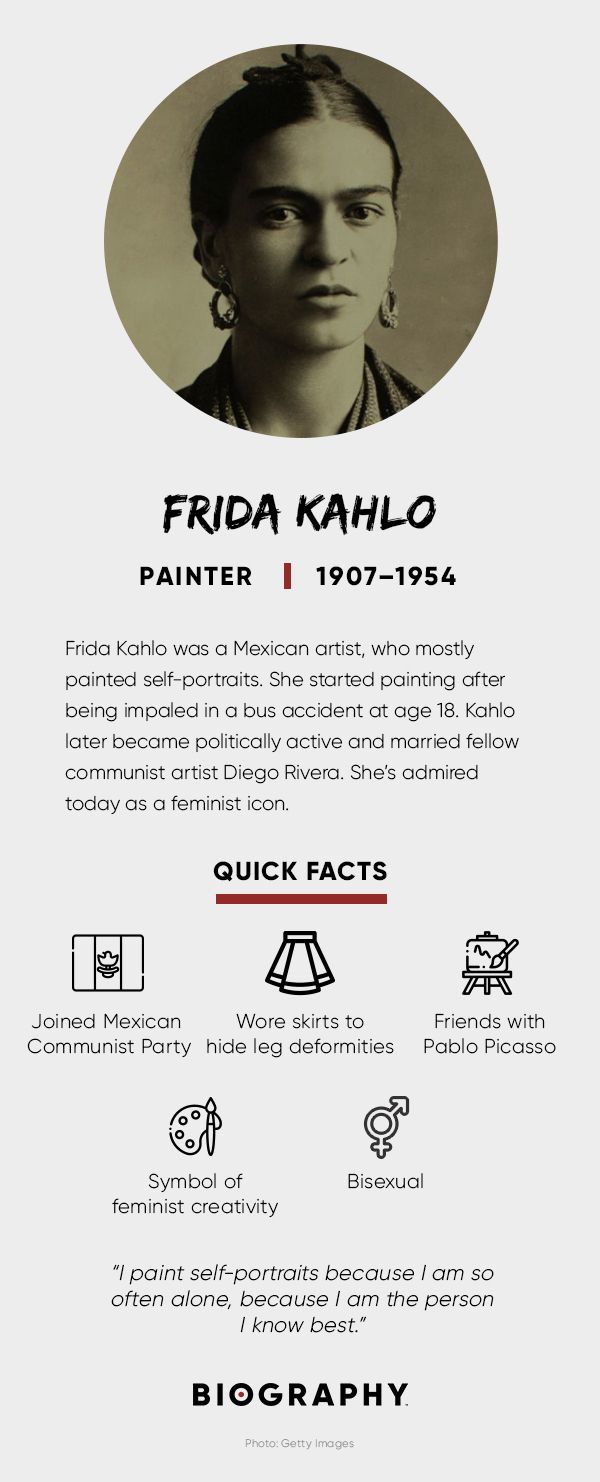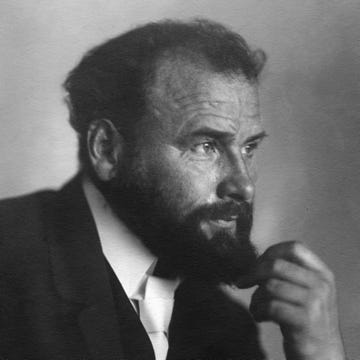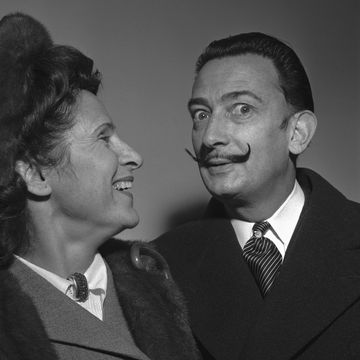(1907-1954)
Who Was Frida Kahlo?
Artist Frida Kahlo was considered one of Mexico's greatest artists who began painting mostly self-portraits after she was severely injured in a bus accident. Kahlo later became politically active and married fellow communist artist Diego Rivera in 1929. She exhibited her paintings in Paris and Mexico before her death in 1954.
Family, Education and Early Life
Kahlo was born Magdalena Carmen Frieda Kahlo y Calderón on July 6, 1907, in Coyoacán, Mexico City, Mexico.
Kahlo's father, Wilhelm (also called Guillermo), was a German photographer who had immigrated to Mexico where he met and married her mother Matilde. She had two older sisters, Matilde and Adriana, and her younger sister, Cristina, was born the year after Kahlo.
Around the age of six, Kahlo contracted polio, which caused her to be bedridden for nine months. While she recovered from the illness, she limped when she walked because the disease had damaged her right leg and foot. Her father encouraged her to play soccer, go swimming, and even wrestle — highly unusual moves for a girl at the time — to help aid in her recovery.
In 1922, Kahlo enrolled at the renowned National Preparatory School. She was one of the few female students to attend the school, and she became known for her jovial spirit and her love of colorful, traditional clothes and jewelry.
While at school, Kahlo hung out with a group of politically and intellectually like-minded students. Becoming more politically active, Kahlo joined the Young Communist League and the Mexican Communist Party.
Frida Kahlo's Accident
On September 17, 1925, Kahlo and Alejandro Gómez Arias, a school friend with whom she was romantically involved, were traveling together on a bus when the vehicle collided with a streetcar. As a result of the collision, Kahlo was impaled by a steel handrail, which went into her hip and came out the other side. She suffered several serious injuries as a result, including fractures in her spine and pelvis.
After staying at the Red Cross Hospital in Mexico City for several weeks, Kahlo returned home to recuperate further. She began painting during her recovery and finished her first self-portrait the following year, which she gave to Gómez Arias.
Frida Kahlo's Marriage to Diego Rivera
In 1929, Kahlo and famed Mexican muralist Diego Rivera married. Kahlo and Rivera first met in 1922 when he went to work on a project at her high school. Kahlo often watched as Rivera created a mural called The Creation in the school’s lecture hall. According to some reports, she told a friend that she would someday have Rivera’s baby.
Kahlo reconnected with Rivera in 1928. He encouraged her artwork, and the two began a relationship. During their early years together, Kahlo often followed Rivera based on where the commissions that Rivera received were. In 1930, they lived in San Francisco, California. They then went to New York City for Rivera’s show at the Museum of Modern Art and later moved to Detroit for Rivera’s commission with the Detroit Institute of Arts.
Kahlo and Rivera’s time in New York City in 1933 was surrounded by controversy. Commissioned by Nelson Rockefeller, Rivera created a mural entitled Man at the Crossroads in the RCA Building at Rockefeller Center. Rockefeller halted the work on the project after Rivera included a portrait of communist leader Vladimir Lenin in the mural, which was later painted over. Months after this incident, the couple returned to Mexico and went to live in San Angel, Mexico.
Never a traditional union, Kahlo and Rivera kept separate, but adjoining homes and studios in San Angel. She was saddened by his many infidelities, including an affair with her sister Cristina. In response to this familial betrayal, Kahlo cut off most of her trademark long dark hair. Desperately wanting to have a child, she again experienced heartbreak when she miscarried in 1934.
Kahlo and Rivera went through periods of separation, but they joined together to help exiled Soviet communist Leon Trotsky and his wife Natalia in 1937. The Trotskys came to stay with them at the Blue House (Kahlo's childhood home) for a time in 1937 as Trotsky had received asylum in Mexico. Once a rival of Soviet leader Joseph Stalin, Trotsky feared that he would be assassinated by his old nemesis. Kahlo and Trotsky reportedly had a brief affair during this time.
Kahlo divorced Rivera in 1939. They did not stay divorced for long, remarrying in 1940. The couple continued to lead largely separate lives, both becoming involved with other people over the years.
Artistic Career
While she never considered herself a surrealist, Kahlo befriended one of the primary figures in that artistic and literary movement, Andre Breton, in 1938. That same year, she had a major exhibition at a New York City gallery, selling about half of the 25 paintings shown there. Kahlo also received two commissions, including one from famed magazine editor Clare Boothe Luce, as a result of the show.
In 1939, Kahlo went to live in Paris for a time. There she exhibited some of her paintings and developed friendships with such artists as Marcel Duchamp and Pablo Picasso.
Kahlo received a commission from the Mexican government for five portraits of important Mexican women in 1941, but she was unable to finish the project. She lost her beloved father that year and continued to suffer from chronic health problems. Despite her personal challenges, her work continued to grow in popularity and was included in numerous group shows around this time.
In 1953, Kahlo received her first solo exhibition in Mexico. While bedridden at the time, Kahlo did not miss out on the exhibition’s opening. Arriving by ambulance, Kahlo spent the evening talking and celebrating with the event’s attendees from the comfort of a four-poster bed set up in the gallery just for her.
After Kahlo’s death, the feminist movement of the 1970s led to renewed interest in her life and work, as Kahlo was viewed by many as an icon of female creativity.
Frida Kahlo's Most Famous Paintings
Many of Kahlo’s works were self-portraits. A few of her most notable paintings include:
'Frieda and Diego Rivera' (1931)
Kahlo showed this painting at the Sixth Annual Exhibition of the San Francisco Society of Women Artists, the city where she was living with Rivera at the time. In the work, painted two years after the couple married, Kahlo lightly holds Rivera’s hand as he grasps a palette and paintbrushes with the other — a stiffly formal pose hinting at the couple’s future tumultuous relationship. The work now lives at the San Francisco Museum of Modern Art.
'Henry Ford Hospital' (1932)
In 1932, Kahlo incorporated graphic and surrealistic elements in her work. In this painting, a naked Kahlo appears on a hospital bed with several items — a fetus, a snail, a flower, a pelvis and others — floating around her and connected to her by red, veinlike strings. As with her earlier self-portraits, the work was deeply personal, telling the story of her second miscarriage.
'The Suicide of Dorothy Hale' (1939)
Kahlo was asked to paint a portrait of Luce and Kahlo's mutual friend, actress Dorothy Hale, who had committed suicide earlier that year by jumping from a high-rise building. The painting was intended as a gift for Hale's grieving mother. Rather than a traditional portrait, however, Kahlo painted the story of Hale's tragic leap. While the work has been heralded by critics, its patron was horrified at the finished painting.
'The Two Fridas' (1939)
One of Kahlo’s most famous works, the painting shows two versions of the artist sitting side by side, with both of their hearts exposed. One Frida is dressed nearly all in white and has a damaged heart and spots of blood on her clothing. The other wears bold colored clothing and has an intact heart. These figures are believed to represent “unloved” and “loved” versions of Kahlo.
'The Broken Column' (1944)
Kahlo shared her physical challenges through her art again with this painting, which depicted a nearly nude Kahlo split down the middle, revealing her spine as a shattered decorative column. She also wears a surgical brace and her skin is studded with tacks or nails. Around this time, Kahlo had several surgeries and wore special corsets to try to fix her back. She would continue to seek a variety of treatments for her chronic physical pain with little success.
Frida Kahlo’s Death
About a week after her 47th birthday, Kahlo died on July 13, 1954, at her beloved Blue House. There has been some speculation regarding the nature of her death. It was reported to be caused by a pulmonary embolism, but there have also been stories about a possible suicide.
Kahlo’s health issues became nearly all-consuming in 1950. After being diagnosed with gangrene in her right foot, Kahlo spent nine months in the hospital and had several operations during this time. She continued to paint and support political causes despite having limited mobility. In 1953, part of Kahlo’s right leg was amputated to stop the spread of gangrene.
Deeply depressed, Kahlo was hospitalized again in April 1954 because of poor health, or, as some reports indicated, a suicide attempt. She returned to the hospital two months later with bronchial pneumonia. No matter her physical condition, Kahlo did not let that stand in the way of her political activism. Her final public appearance was a demonstration against the U.S.-backed overthrow of President Jacobo Arbenz of Guatemala on July 2nd.
Movie on Frida Kahlo
Kahlo’s life was the subject of a 2002 film entitled Frida, starring Salma Hayek as the artist and Alfred Molina as Rivera. Directed by Julie Taymor, the film was nominated for six Academy Awards and won for Best Makeup and Original Score.
Frida Kahlo Museum
The family home where Kahlo was born and grew up, later referred to as the Blue House or Casa Azul, was opened as a museum in 1958. Located in Coyoacán, Mexico City, the Museo Frida Kahlo houses artifacts from the artist along with important works including Viva la Vida (1954), Frida and Caesarean (1931) and Portrait of my father Wilhelm Kahlo (1952).
Book on Frida Kahlo
Hayden Herrera’s 1983 book on Kahlo, Frida: A Biography of Frida Kahlo, helped to stir up interest in the artist. The biographical work covers Kahlo’s childhood, accident, artistic career, marriage to Diego Rivera, association with the communist party and love affairs.
QUICK FACTS
- Name: Frida Kahlo
- Birth Year: 1907
- Birth date: July 6, 1907
- Birth City: Mexico City
- Birth Country: Mexico
- Gender: Female
- Best Known For: Painter Frida Kahlo was a Mexican artist who was married to Diego Rivera and is still admired as a feminist icon.
- Industries
- Art
- Astrological Sign: Cancer
- Schools
- National Preparatory School
- Nacionalities
- Mexican
- Interesting Facts
- Frida Kahlo met Diego Rivera when he was commissioned to paint a mural at her high school.
- Kahlo dealt with chronic pain most of her life due to a bus accident.
- Death Year: 1954
- Death date: July 13, 1954
- Death City: Mexico City
- Death Country: Mexico
Fact Check
We strive for accuracy and fairness.If you see something that doesn't look right,contact us!
CITATION INFORMATION
- Article Title: Frida Kahlo Biography
- Author: Biography.com Editors
- Website Name: The Biography.com website
- Url: https://www.biography.com/artists/frida-kahlo
- Access Date:
- Publisher: A&E; Television Networks
- Last Updated: November 19, 2021
- Original Published Date: April 2, 2014
QUOTES
- I never paint dreams or nightmares. I paint my own reality.
- My painting carries with it the message of pain.
- I paint self-portraits because I am so often alone, because I am the person I know best.
- I think that, little by little, I'll be able to solve my problems and survive.
- The only thing I know is that I paint because I need to, and I paint whatever passes through my head without any other consideration.
- I was born a bitch. I was born a painter.
- I love you more than my own skin.
- I am not sick, I am broken, but I am happy as long as I can paint.
- Feet, what do I need you for when I have wings to fly?
- I tried to drown my sorrows, but the bastards learned how to swim, and now I am overwhelmed with this decent and good feeling.
- There have been two great accidents in my life. One was the trolley and the other was Diego. Diego was by far the worst.
- I hope the end is joyful, and I hope never to return.
The Biography.com staff is a team of people-obsessed and news-hungry editors with decades of collective experience. We have worked as daily newspaper reporters, major national magazine editors, and as editors-in-chief of regional media publications. Among our ranks are book authors and award-winning journalists. Our staff also works with freelance writers, researchers, and other contributors to produce the smart, compelling profiles and articles you see on our site. To meet the team, visit our About Us page: https://www.biography.com/about/a43602329/about-us













